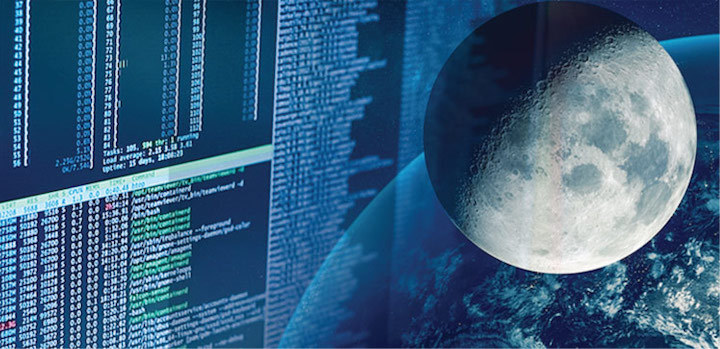13.07.2021
Machine learning accelerates the search for promising Moon sites for energy and mineral resources.

Machine learning can be used to rapidly identify and classify craters and rilles on the Moon from telescope images.
© 2021 Shutterstock/KAUST; Anastasia Serin.
KAUST scientists have developed a machine learning method to explore the surface of the moon. © 2021 KAUST; Anastasia Serin. https://discovery.kaust.edu.sa/en/article/1152/training-an-ai-eye-on-the-moon
A Moon-scanning method that can automatically classify important lunar features from telescope images could significantly improve the efficiency of selecting sites for exploration.
There is more than meets the eye to picking a landing or exploration site on the Moon. The visible area of the lunar surface is larger than Russia and is pockmarked by thousands of craters and crisscrossed by canyon-like rilles. The choice of future landing and exploration sites may come down to the most promising prospective locations for construction, minerals or potential energy resources. However, scanning by eye across such a large area, looking for features perhaps a few hundred meters across, is laborious and often inaccurate, which makes it difficult to pick optimal areas for exploration.
Siyuan Chen (pictured above) and Professor Xin Gao used machine learning and AI to identify promising lunar areas for the exploration of precious resources, such as uranium and helium-3.
© 2021 KAUST; Anastasia Serin
Siyuan Chen, Xin Gao and Shuyu Sun, along with colleagues from The Chinese University of Hong Kong, have now applied machine learning and artificial intelligence (AI) to automate the identification of prospective lunar landing and exploration areas.
“We are looking for lunar features like craters and rilles, which are thought to be hotspots for energy resources like uranium and helium-3 — a promising resource for nuclear fusion,” says Chen. “Both have been detected in Moon craters and could be useful resources for replenishing spacecraft fuel.”
Machine learning is a very effective technique for training an AI model to look for certain features on its own. The first problem faced by Chen and his colleagues was that there was no labeled dataset for rilles that could be used to train their model.
“We overcame this challenge by constructing our own training dataset with annotations for both craters and rilles,” says Chen. “To do this, we used an approach called transfer learning to pretrain our rille model on a surface crack dataset with some fine tuning using actual rille masks. Previous approaches require manual annotation for at least part of the input images —our approach does not require human intervention and so allowed us to construct a large high-quality dataset.”
The next challenge was developing a computational approach that could be used to identify both craters and rilles at the same time, something that had not been done before.
“This is a pixel-to-pixel problem for which we need to accurately mask the craters and rilles in a lunar image,” says Chen. “We solved this problem by constructing a deep learning framework called high-resolution-moon-net, which has two independent networks that share the same network architecture to identify craters and rilles simultaneously.”
The team’s approach achieved precision as high as 83.7 percent, higher than existing state-of-the-art methods for crater detection.
Quelle: King Abdullah University of Science and Technology
